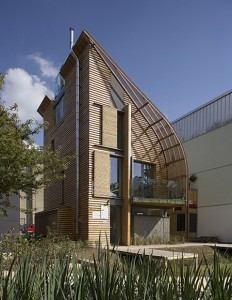
Ashley Halligan from Software Advice
Guest post by Ashley Halligan, an analyst at Software Advice.
As the idea of “net zero” building gains momentum, some are still a little confused about its implications, how to achieve it, and if the idea of wide-scale achievement is more wishful thinking than it is reality.
Several experts chimed in offering their takeaways on the subject, first beginning with an agreed upon definition of “net zero:”
“Net zero indicates that a building has generated at least as much power as it has consumed over a 12-month benchmarking period.”
The twelve-month period assures that seasonality and weather-related factors have had a chance to balance their effects over time.
First off, how does an existing facility achieve net zero consumption through retrofitting and making upgrades. Jeff Blankman, McCormick’s Sustainable Manufacturing Manager, says “The most important maneuver in a net zero makeover is to focus on energy efficiency first. You must reduce consumption–making a facility as efficient as possible.”
McCormick, the food conglomerate, announced its net zero achievement at a Belcamp, Maryland distribution center–that just so happened to be 363,000 square feet. Blankman accredits the achievement to standard energy efficiency upgrades–efficient lighting, HVAC, and motion sensors–which resulted in a 55 percent reduction in energy consumption.
After signing a Power Purchase Agreement with Constellation Energy, photovoltaic solar panels were installed on the distribution center’s rooftop, which–after the 12-month benchmarking period–resulted in not only net zero consumption, but also an energy surplus.
As for new design projects, experts suggested the following four considerations to keep in mind.
1) Eco-charrettes or integrated planning in the pre-design phase–incorporating the ideas of stakeholders, the facility management team, the design team, and the actual builders.
2) Carefully research funding options and potential incentives. There are reimbursement opportunities as well as tax breaks and funding options at both state and federal levels. Researching these opportunities in advance can provide cost savings in the building process.
3) Conduct energy and cost modeling in advance–and do so without expecting unrealistic performance expectations. To accurately predict consumption with innumerable factors post-occupancy. Energy modeling provides a model to reduce cold air, maximize sunlight absorption, and appropriately insulate.
4) Be prepared for ongoing challenges and the need for regular oversight; otherwise your project’s performance can significantly wander. A commitment to ongoing performance standards will require a close relationship with data analysis on a regular basis.
Experts also weighed-in on their perspectives of whether or not this is an achievable endeavor on a wide-scale basis. To read more of their takeaways visit Software Advice’s website, and read: Breaking Down Net Zero Building: Reality or Wishful Thinking?

Leave a Reply